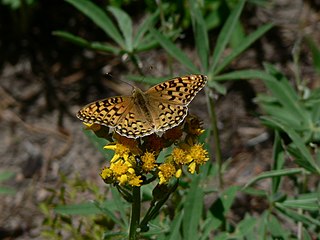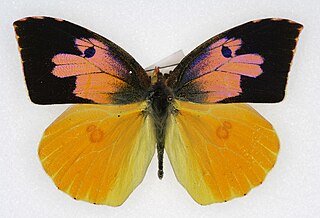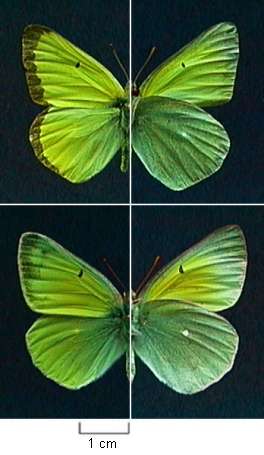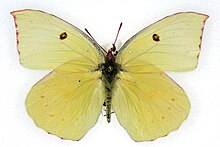
The Pieridae are a large family of butterflies with about 76 genera containing about 1,100 species, mostly from tropical Africa and tropical Asia with some varieties in the more northern regions of North America and Eurasia. Most pierid butterflies are white, yellow, or orange in coloration, often with black spots. The pigments that give the distinct coloring to these butterflies are derived from waste products in the body and are a characteristic of this family. The family was created by William John Swainson in 1820.

Coliadinae, the sulphurs or yellows, are a subfamily of butterflies with about 300 described species.

Speyeria zerene, the zerene fritillary, is a butterfly found in the western portions of the United States and Canada. The species was first described by William John Swainson in 1827.

Colias croceus, clouded yellow, is a small butterfly of the family Pieridae, the yellows and whites.

Colias hyale, the pale clouded yellow, is a butterfly of the family Pieridae, which is found in most of Europe and large parts of the Palearctic. It is a rare migrant to the British Isles and Scandinavia. The adult wingspan is 52–62 millimetres (2.0–2.4 in).

Colias alfacariensis, Berger's clouded yellow, is a butterfly of the family Pieridae. It was separated from the pale clouded yellow, C. hyale, in 1905. Berger's clouded yellow is a Palearctic species (South and Central Europe, South Russia, Russian Far East, Siberia Central Asia and temperate China also Asia Minor, Caucasus and Transcaucasia.

Colias is a genus of butterflies in the family Pieridae. They are often called clouded yellows in the Palearctic and sulphurs in North America. The closest living relative is the genus Zerene, which is sometimes included in Colias.

Colias palaeno, known by the common names moorland clouded yellow, palaeno sulphur, and pale Arctic clouded yellow, is a butterfly in the family Pieridae.

Zerene cesonia, the southern dogface, is a North and South American butterfly in the family Pieridae, subfamily Coliadinae.

Colias philodice, the common sulphur or clouded sulphur, is a North American butterfly in the family Pieridae, subfamily Coliadinae.

Colias phicomone, the mountain clouded yellow, is a butterfly in the family Pieridae. It is found in the Cantabrian Mountains, the Pyrenees, the Carpathian Mountains and the Alps. It flies at altitudes of 900 to 2800 meters.

Colias myrmidone, the Danube clouded yellow, is a butterfly in the family Pieridae.

Colias nastes, the Labrador sulphur, is a butterfly in the family Pieridae. In Europe, it is found in the north of Norway and Sweden and on rare occasions in northern Finland. It is also found in North America, specifically in Alaska, Canada, and the Rocky Mountains, Washington, Montana and on Greenland. In Asia, it is found in the Altai Mountains, the border regions of Russia, China, Mongolia, Kazakhstan, the Sayan Mountains, the north of Siberia, and in the Chukotka Autonomous Okrug.

Zerene is a genus of butterflies in the family Pieridae commonly called dogfaces. The closest living relative is the genus Colias. They are migratory.
Butterflies, or members of the Papilionoidea superfamily, use two ultraviolet signals, UV reflectance or absorbance as a communication system. The ultraviolet region is the part of the electromagnetic spectrum between 10 nm and 400 nm in wavelength. Sensitivity to this region provides butterflies several benefits such as nectar guides for nectar, but it also provides a private communication channel unavailable to predators. With this secure line, butterflies are able to facilitate mating behavior and sex recognition.

Colias alexandra, the Queen Alexandra's sulphur, Alexandra sulphur, or ultraviolet sulfur, is a butterfly in the family Pieridae found in western North America. Its range includes Alaska to the Northwest Territories and south to Arizona and New Mexico.

Colias lesbia is a species of butterfly in the family Pieridae. It is found in the Neotropical realm.

Colias romanovi is a butterfly in the family Pieridae. It is found in the eastern Palearctic realm.
The Lorquin Entomological Society is a century-old association of professional and amateur entomologists, biologists and naturalists that meet regularly to study and promote entomology and natural history, especially about wildlife in and near Southern California.



















